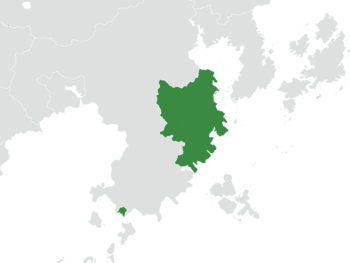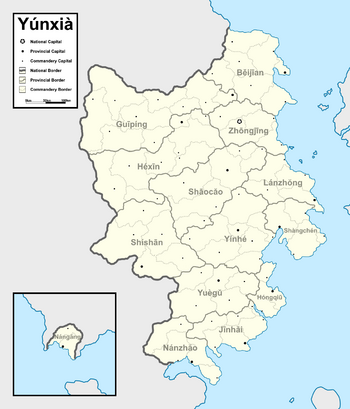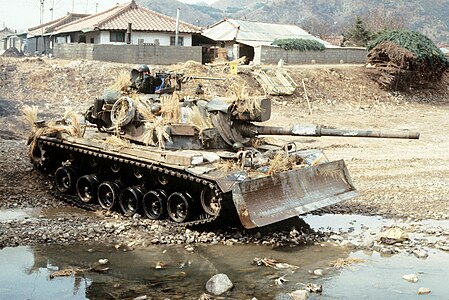Yunxia: Difference between revisions
mNo edit summary |
|||
| Line 150: | Line 150: | ||
===Military=== | ===Military=== | ||
The armed forces of the Junting clique are the largest official military in Yunxia. The Junting Army comprises 300,000 active service personnel, approximately two-thirds of which are members of the Ground Force. A further 150,000 personnel are members of allegiant military cliques and reserves. It is estimated that the combined numbers of the Jinhai, Shishan, and Seunghoi cliques are approximately 200,000. | |||
The Yunxianese military forces are equipped by a variety of foreign suppliers, including Belfras, Sante Reze, and Tsurushima. The country has a small domestic arms industry as well.<gallery mode="packed" widths="350" heights="200"> | |||
File:US M60 tank with M9 bulldozer kit in South Korea.jpg|Junting Army Ground Force tank during an exercise in northern Beijian Province. | |||
File:F-16D 480th FS taking off Bulgaria 2010.jpg|Junting Army Air Force {{Wp|General_Dynamics_F-16_Fighting_Falcon|Mi-10.2 Taguate}} jet fighter in takeoff. | |||
File:駐港部隊艦艇大隊037II型-772導彈艦 2012a.JPG|Junting Army Maritime Force missile boat on manoeuvres. | |||
</gallery> | |||
==Economy== | ==Economy== | ||
Revision as of 00:36, 17 April 2024
This article is incomplete because it is pending further input from participants, or it is a work-in-progress by one author. Please comment on this article's talk page to share your input, comments and questions. Note: To contribute to this article, you may need to seek help from the author(s) of this page. |
Republic of Yúnxià | |
|---|---|
 Location of Yunxia (dark green) in East Ochran | |
 Map of Yunxia | |
| Capital | Zhōngjīng |
| Official language Regional languages | Xianese Dongese, Manzinese, Beian, Kitaganese, Tsurushimese |
| Demonym(s) | Yunxianese |
| Government | Presidential constitutional republic (de jure) Military administration (de facto) |
• Acting head of state | Generalissimo Fēng Zhīxīn |
• Legislature | National Council (suspended) |
| Establishment | |
• Republic of Yunxia | May 27, 1943 |
• Military administration | November 12, 1944 |
| Area | |
• Total | 1,096,990 km2 (423,550 sq mi) |
• Water (%) | 4.59 |
| Population | |
• 2024 census | 78,474,968 |
• Density | 71.5/km2 (185.2/sq mi) |
| GDP (nominal) | 2024 estimate |
• Total | $856 billion |
• Per capita | $10,905.31 |
| Gini | high |
| HDI (2024) | medium |
| Currency | Fēn (¥) (YXF) |
| Date format | yyyy-mm-d-dd |
| Driving side | right |
| Internet TLD | .yx |
The Republic of Yúnxià is a country in East Ochran. While ostensibly a constitutional republic, since 1944 the country has been governed by a military administration with devolved government along the lines of military districts and historic commandery districts. In practice, the regional governments are divided along cultural and geographic cliques, with significant warlordism beyond the core. Both reactionary and revolutionary elements exert significant influence across the country. The current head of the central government and the Junting Army is Generalissimo Feng Zhixin.
Through most of modern history, the country of Yunxia formed the core of the Shenzhou Empire, a preeminent power in East Ochran. By the early 20th century, the Empire was reduced to a rump state in Yunxia. In 1940, the Empire was overthrown and the Republic of Yunxia was founded. Its first president was subsequently removed in 1944 by a military coup after an attempt to restore the Empire. Initially, the military administration had popular support. Over subsequent decades, the authority of the military administration based in the capital of Zhōngjīng has eroded in favour of local populist movements and militias.
The economy of Yunxia is mixed both in terms of state interventions and development. In the vast hinterlands, a peasant agrarian economy is still commonplace. Closer to the capital, there is considerable industrial development with a focus manufacturing for an export market. The military administration has also designated a number of special international economic zones to promote financial services and foreign investment.
Culturally, Yunxia is a multi-ethnic country, though the majority of the population belong to various Shen sub-ethnicities. The Xianese make up a majority with significant Dongese and Manzinese minorities. The Beian and Kitaganese make up more marginal regional minorities.
History
The historical Shenzhou Empire stretched across a large portion of East Ochran, formed from various Shen peoples and states across the region. The first dynasty of the Shenzhou Empire was formed semi-legendarily sometime in the mid-first millennium BCE and material culture recovered from that era attests the Empire was one of the first centralized states formed in human history. For the next millennium, the Empire existed in various forms with numerous dynastic changes often accompanied by periods of anarchy and warring provinces. Externally, the greatest rivals of the Shen were the Tsurushimese and the Kitaganese, who vied for commercial interests and territorial domination.
In the mid-10th century, the Shenzhou Empire came under threat from the Bayarids to the west. In the early 11th century, the Empire was ultimately conquered by the Bayarids and made a vassal state of the Khanate. The Bayarid Empire gradually collapsed over the 12th century and when the Shen reclaimed the Imperial throne, domestic historiography considered this yet another dynastic change.
By the 16th century, the Empire gained prominence as the terminus of the Jade Road, with trade flourishing following the stabilization of Uluujol to the west. This led to significant economic growth as well as technological and cultural exchange between Belisaria and Ochran.
Despite the size and power of the Shenzhou Empire in the first part of the early modern era, the country did not industrialize on a broad scale and by the 19th century the Empire saw its sphere of influence shrinking. This culminated in defeat in the First Cross Strait War at the end of the century. When the Empire failed in a revanchist war in the 1920s and 30s, the stage was set for the dissolution of the Empire and ultimately the foundation of the Republic of Tianxia following the abdication of the emperor at the end of the Shen Civil War (1936-1943).
The Republic of Yunxia was established on May 27, 1943, and Marshal Wú Kūn was acclaimed as the first president. Several months into his tenure as president, Wú launched a self-coup, refounding the Shenzhou Empire with himself as emperor. On November 12, 1944, the Junting clique toppled Wú and officially restored the republic, though a military government was instituted to restore order while the constitution was suspended. Since then, a succession of military dictators have ruled the country, interspersed with periods of instability and conflict between competing military and political cliques.
Geography and climate
The majority of Yunxia's area is located in the Great Xia Plain, a large basin delineated by highlands in the west and alluvial plains in the east. The region was an early human agricultural centre, though soil fertility has declined over several millennia of human development.
Modern Yunxia is marked by many rivers flowing through it which have both delineated its regions and served as major thoroughfares through the empire. In early-modern times, the Shenzhou Empire was occasionally known as the Thousand River Empire.
The exclave of Nangang is not contiguous with the rest of modern Yunxia and is part of a separate geographic region characterized by coastal mountains.
Flora and fauna
Yunxia is home to a large amount of biodiversity. Primates, and big cats are distributed across the southwest of the country, including Nangang. Various species of mustelids are widely distributed across the entire country, including sables and wolverines. Gamebirds and cranes are common birds across the region as well.
In the northwest of the country, cypress and redwood trees are common in mountain and cold coniferous forests. Mangrove and deciduous jungle forests are more common in the south. Bamboo thickets are common throughout the country, but especially in the south and along the coasts where rainfall is heavier.
Climate
The majority of Yunxia falls under a subtropical climate classification with wet-dry tropical climate in the south. The western highlands have both steppe climates and some areas of tundra in mountainous regions. Nangang has a mountainous tropical climate.
Government and politics
Administrative subdivisions
The Republic of Yunxia is ostensibly a unitary state subdivided into 14 provinces, with each province subdivided into a number of commanderies and further into municipalities. Presently, the province with the fewest commanderies is Nangang with only two, while Guiping has nine. The provincial system was first devised by the Zi dynasty in the third century BCE, though it was frequently modified and borders have been redrawn through history. Yunxia's modern internal borders are generally the same as they were during the 19th century Huang dynasty with some modifications from the 1943 revolution.
Historically, provinces were ruled by governors appointed by the emperor as direct representatives of the imperial rule. Following the revolution, governors were ostensibly elected democratically, though under the regime of the Junting military administration, the roles of governors have been assumed by acting military officers. In terms of the divisions of powers, provinces each have their own court systems and economic policies which are still ostensibly determined by the central state.
Commanderies are lower-level subdivisions, historically based around conscription and taxation districts within a province. At present, commanderies maintain a similar purpose as military districts and local administrative units responsible for the administration of healthcare and education as well as the collection of taxes and census data. A commandery is administered by a castellan: a pseudo-military magisterial role appointed by the central government.
The lowers level of subdivisions are municipalities: counties, and cities. These subdivisions are primarily responsible for local zoning and infrastructure, but are ultimately subordinated to their commanderies. Counties are predominantly rural locales constituting a number of townships or villages with low population density. Cities are municipal districts with specific charters and allowances to accommodate infrastructure for dense population. Most cities have greater populations than a given county. Modern counties are administered by local magistrates while cities are often operated by an elected or appointed council.
Cliques and regional organization
The main organization behind the military administration of the Republic of Yunxia is the Junting clique, the civil war faction that overthrew Emperor Wu in 1944 to restore the republic. The Junting clique originates from the Junting Military Academy of the city of Jiāngsan in Lanzhong Province. The military academy's faculty and student body took a central role in the military resistance to the Imperial government from the early 1940s, ultimately leading the Siege of Zhongjing which ended the civil war. Since 1944, the Junting clique has occupied the capital and maintained significant influence with the dean of the academy simultaneously presiding as the acting head of state of Yunxia and commander-in-chief of its official armed forces.
Across contiguous Yunxia, the Junting clique is politically rivalled by two other factions: the Shishan clique in the southwest and the Jinhai clique in the southeast. In addition, the Province of Nangang is contested by the local Seunghoi clique. In general, Yunxianese cliques are not divided among strictly ideological lines. In theory, the Junting, Shishan, and Jiinhai cliques each profess liberal democratic beliefs and aspire to restore a united republic. Each clique advocates for a free market economy with protections for peasant agricultural workers and foreign industrial development in manufacturing. The Seunghoi clique is unique in that it is explicitly a Manzinese separatist movement that seeks to expel foreign economic exploitation of Nangang Province. In addition to the major four cliques, smaller movements maintain influence over the countryside as well.
Each of the major cliques are more accurately described as being in state of competitive jockeying for influence rather than open hostility. Aside from the Seunghoi clique, the major three present a unified front regarding foreign relations, but local commerce is frequently disrupted across internal borders.
Foreign relation
Yunxia maintains positive multi-polar relations with the world's strongest global economic powers. This has largely been facilitated through the special international economic zones along the east coast which provide foreign state and corporate entities with access to commercial and manufacturing centres with exceptions to tariffs and regulations. Yunxia's foreign policy has not specifically aligned with capitalist, socialist, monarchist, or republican lines. Major international trading partners include Tsurushima, Belfras, Sante Reze, and Latium.
Aside from Tsurushima, Yunxia maintains cooler relations with its regional neighbours. In particular, Yunxia has a mixed relationship with Daobac which shares a maritime border with Nangang Province. Post-Hanaki War, Daobac was granted access to resources in Nangang as war reparations. However, both countries have cooperated in countering the separatist Seunghoi clique in Nangang.
Military
The armed forces of the Junting clique are the largest official military in Yunxia. The Junting Army comprises 300,000 active service personnel, approximately two-thirds of which are members of the Ground Force. A further 150,000 personnel are members of allegiant military cliques and reserves. It is estimated that the combined numbers of the Jinhai, Shishan, and Seunghoi cliques are approximately 200,000.
The Yunxianese military forces are equipped by a variety of foreign suppliers, including Belfras, Sante Reze, and Tsurushima. The country has a small domestic arms industry as well.
Junting Army Air Force Mi-10.2 Taguate jet fighter in takeoff.




